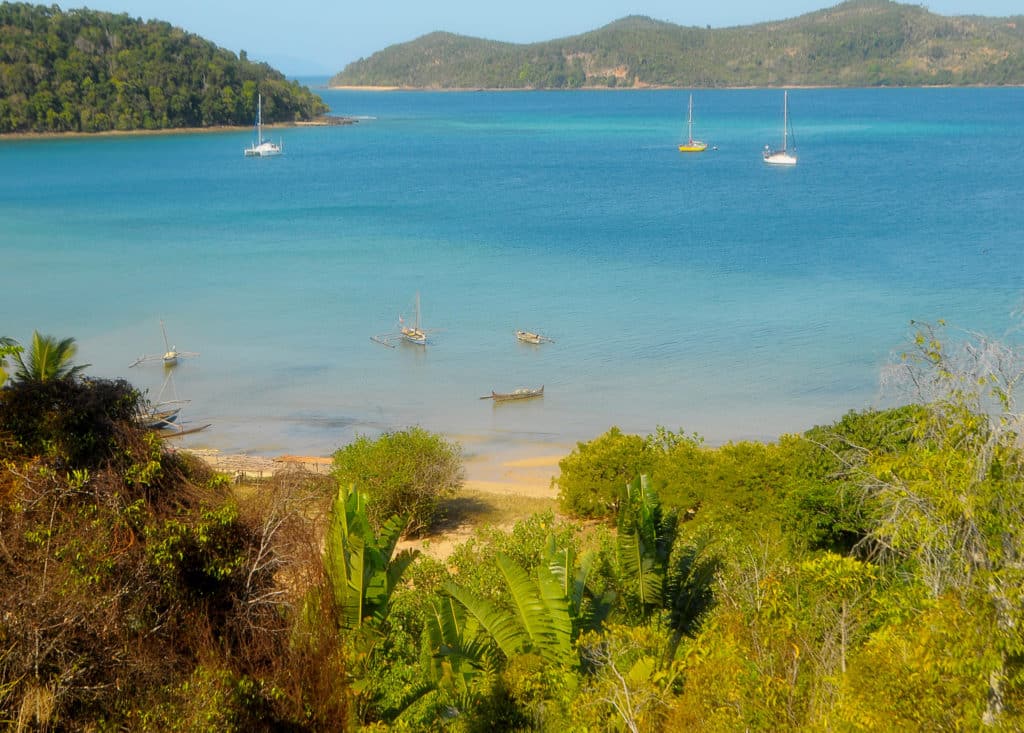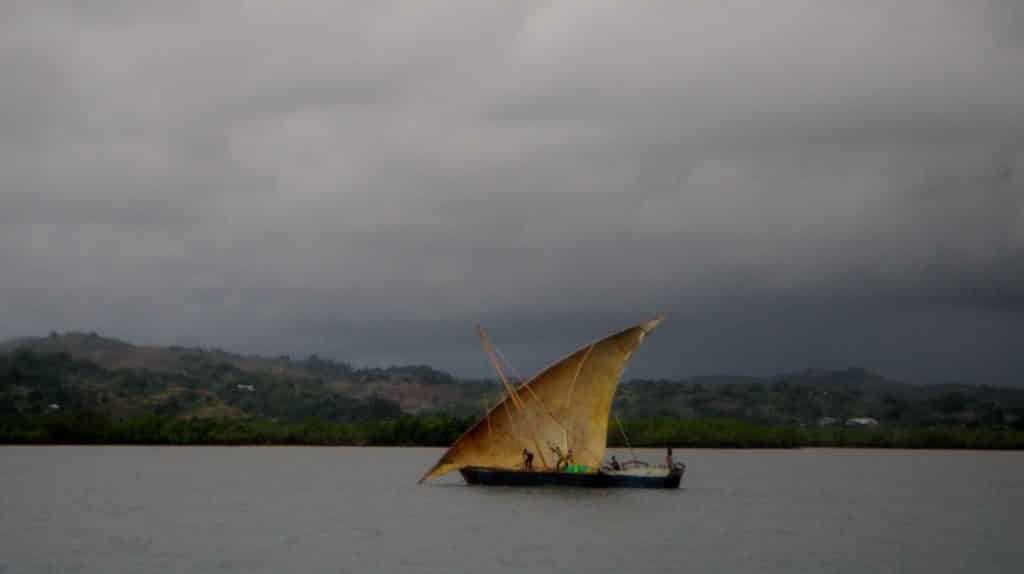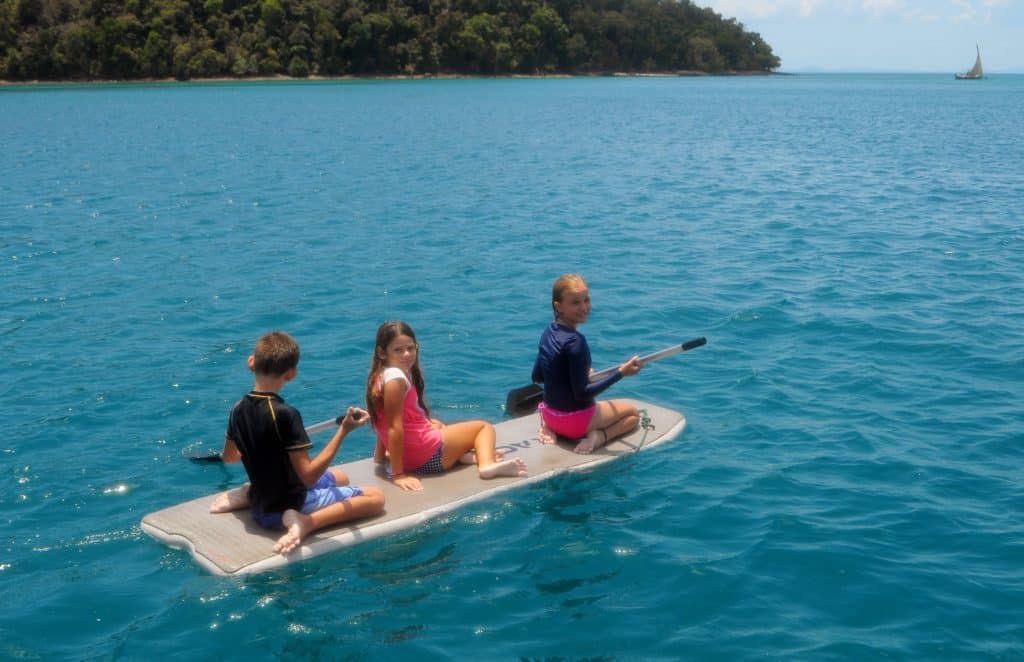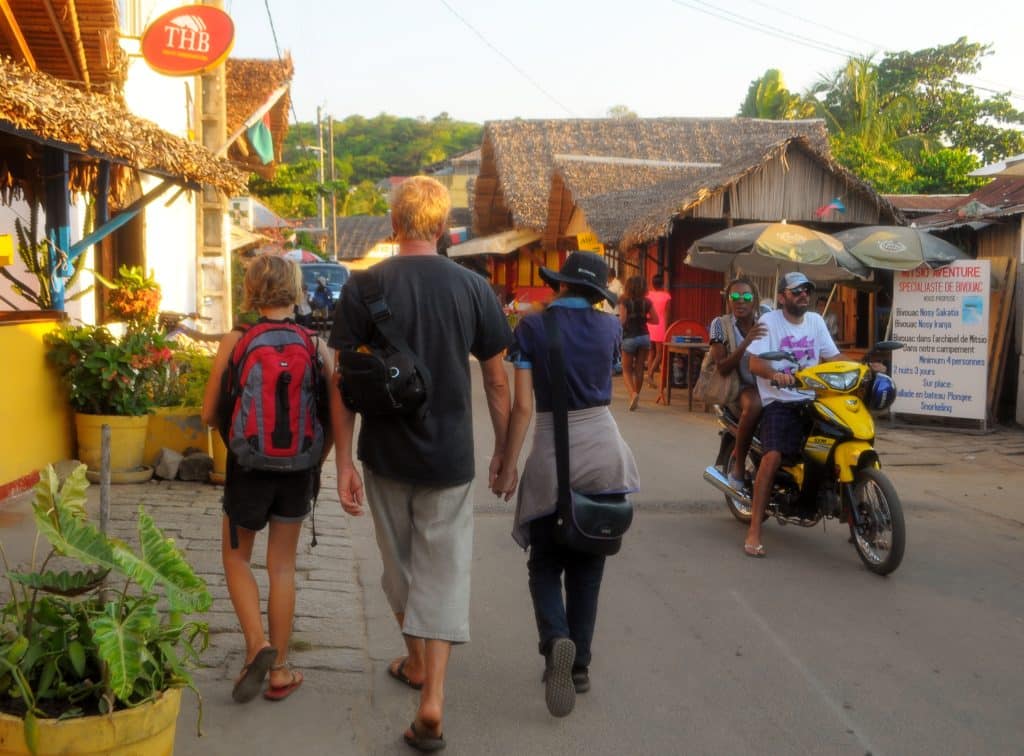
We play a game on Momo, our Mason 43. When we arrive in a new place, we throw out our first impressions before we have time to build up anything else. Before we establish any rhythm or create any lasting feelings. Then, after spending a few months in the place, we compare notes to see how our early impressions have deepened or changed. In Indonesia, our crew of four — my husband, Bernie, daughters Lola and Jana, and me — arrived in the Kai Islands after spending 10 years in the Pacific. We noted our early impressions in the log: “Gentle, active, smiling, loud, curious, welcoming, photo-obsessed, smoking, Islamic.”
Then, after nearly two years in Southeast Asia, we arrived on the other side of the Indian Ocean in what felt like the other side of the world.
“Bustling, colorful, uninhibited, sails, dusty, poor, welcoming, bright, edgy, energetic, red dirt, thrumming, loud,” I wrote in the log when we arrived in Madagascar.
Even before we arrived, we could smell Madagascar from offshore: the hint of burning wood and grass, something green, something else faintly sickening and almost sweet. Something mysterious, something ancient — but new to us. We snapped photos of our colorful first impressions: dancing women and children, drumming men and boys. Embroidered tablecloths and post-colonial police stations. Friendly lemurs that reminded us of Madagascar, the animated movie, and curious chameleons. Ebony zebu herded along dusty red roads. Silvery fish drying in the subtropical sun. Fishing kids and sailing skiffs.
But there was more to Madagascar, more than we’d understand even if we stayed on a while.
Just east of Mozambique, Madagascar is the fourth-largest island in the world. Its culture is a delightful convergence of Europe, Africa and the Middle East, as evidenced by the gourmet French meals, baked goods, mélange of rum drinks, vibrant materials for both traditional and modern dress, and the combination of French and local Malagasy language. A fleet of sailing dhows scatter up and down the coastline daily, triangular sails set against the rising and setting sun, reminiscent of traditional Arab sailing vessels.
In Madagascar we found lemurs, ylang-ylang, distilled rum, vanilla, dancing, late-night revelry, lazy mornings and lavish lunches.
We arrived in late August after 25 days’ sailing from Sumatra. We were originally headed for Rodrigues, but had changed our plan midcourse when the Indian Ocean got a little too rowdy. The weather maps showed more intense wind and waves to the southwest, so we bore away 30 degrees. By the time we rounded Cap d’Ambre, Madagascar’s northern tip, and began the comparably softer sailing down the protected northwest coast toward the island of Nosy Be, we were happy to have made the change in course. We were sorry to miss Rodrigues and had added an extra 500 miles to our passage, but who can complain when you drop anchor after more than 3,000 miles in a town called Hell-Ville? We just had to chuckle.

One of the first things we noticed when we set the hook in Hell-Ville, as the city of Andoany is commonly known, is that it’s a sailing world. We quickly discovered that the people of coastal Madagascar rely on the local breezes to bring them out into the bay and back again. Madagascar is out of the trade winds, so the breezes are land- and sea-based. The wooden dhows we saw had no motors — a stark contrast to the lineup of Yamahas we’d seen in Mexico. We didn’t hear boats vroom-vrooming or tuk-tuking by; instead they sailed in and out of the crowded anchorages at all hours of the morning and night. If the late-night breeze petered out, they dropped anchor until morning. Many nights I watched a dhow ghost past our hull, close enough to reach out and touch, before pulling quietly into the shallows.
Some of the dhows we saw fished locally in and around Hell-Ville and returned each day. Others fished around their villages and dried the catch on large wooden racks, bringing their goods to the city for sale. Some larger boats sailed around the main anchorages of Nosy Be with tourists on board, ferrying them to nearby island resorts. All of the boats we saw relied on the wind and the wind alone.
In the mornings, we sat on our bow with our coffee, watching the line of boats sail out; in the evenings, we did the same, watching the line of boats sail in. It was easy to feel the breath and rhythm of the place from the glassy anchorage. Nosy Be inhaled and exhaled with the offshore and onshore breeze.
During the first few days of our stay in Hell-Ville, a music festival got riotously underway. The festival kicked off with a parade that noisily marched by a bar where we were lunching with a few other visiting cruisers. We followed the crowd along the waterfront road to a very large field with a main stage and a perimeter lined with makeshift bars and restaurants. Women prepared food in the back; children played out front. A girl selling cupcakes made her rounds; a boy balancing a plate of bread smiled sweetly. The parade participants were called to the stage to perform again and receive congratulations or possibly awards; we couldn’t tell because no one in our group spoke Malagasy. We learned quickly how to go with the flow. We drank local beer and a soda that tasted like bubble gum; then, over the ensuing days, we drank more beer and avoided the bubble-gum soda. Some of us even danced.
We were met by an outwardly open attitude during those festival days. A light celebratory feeling permeated the air. In cafes, people chatted with us from the next table over, reaching out to shake hands with our children. “I’m playing in the bar two doors down,” an elegant and commanding woman we met told us one afternoon. “Here’s my number!” Didia, it turned out, is from Nosy Be but now lives in Paris; she was back in town for the big music festival.
We never did make it to see Didia sing, but the music raged on for four days and nights. Some nights we just enjoyed the driving percussion and heavy bass thrum of the salegy rhythms from the bow of Momo. Nightclubs and bars overflowed with gyrating men and women, and the field we had visited on the first day was filled each night with partygoers, with the mood building to the climax on the last night as Madagascar’s top salegy performer, Wawa, took the stage. To one side of the field was another field: the designated latrine. I didn’t go there myself, but reports from my husband and friends made me glad I never had to. We could only assume that the field is well fertilized by the end of each of these community festivals.

Shortly after the festival, we set sail to explore other nearby islands and villages. We laughed each time we pulled up our anchor and sailed in and out of anchorages, thinking back to our early days on our engineless Triton in the Chesapeake. Back then, we had come to grips with sailing in and out of tight places by necessity. Now we did it because it was fun. Unlike in Southeast Asia, where we drifted many an afternoon or night, we could almost always sail in Madagascar from one island anchorage to the next. The breeze was predictable and steady. The pattern was easy: In the mornings, when there was little wind, we readied the boat, gathered groceries or completed last-minute chores. Then, by midday, when the westerly breeze filled in, we pulled up the anchor and set sail for a new anchorage on the next island over. The next destination was never very far. Within 40 miles of Nosy Be, we found a dozen good anchorages with clear water for snorkeling and diving, beaches for roaming and playing, and villages for visiting and socializing.
Each island we stopped at was more memorable than the last. At picturesque Nosy Sakatia, northwest of Nosy Be, whales gently meandered through the pass and cruiser kids splashed from one boat to the next. In the well-protected and roomy Baie des Russes (also known as Russian Bay or Ambavatory Bay), sailors gathered for barbecues and even two birthday parties. Lemurs were everywhere on the small island of Nosy Iranja and came to greet us almost as soon as we’d set foot onshore. We made a day stop at Nosy Tanikely, where the crystal waters and diversity of life around the coral reef beckon divers from around the world.
We picked up some of our favorite local carvings and crafts and soaked up the hospitality of the restaurants of Nosy Komba, and topped up from a water source offered by Yolanda’s, a cruiser-friendly local eatery right on the beach. In Honey River, we were given a small dried fish, which locals use as an exfoliator (we think, based on the broken French and gesturing). We hung this most peculiar keepsake on Momo to remind ourselves of this generous villager who insisted he offer a gift (perhaps as compensation for having to deny our enthusiastic request for honey).
At Crater Bay, the cruising hub of northwest Madagascar, we were welcomed at the yacht club for a Sunday pig roast, a weeknight pizza and the Rugby World Cup, which we enthusiastically watched with sailors from Australia, South Africa and our beloved New Zealand.
We stopped in the archipelago Nosy Mitsio, only 30 miles north of Nosy Be but far from the noise. With beautiful bays both east and west (and a couple of small villages), the largest island of Mitsio offered plenty to explore, and we found fantastic harbors for swimming at the nearby surrounding islands.
But even as we sailed from anchorage to anchorage, smiling and dancing our way through each new encounter, and even as we snapped photos that captured the vibrancy of Madagascar, I realized we couldn’t photograph the underlying cultural rhythms and tones. Poverty begets petty crime and sometimes more dramatic instances of violence on the island, and there is an inevitable clash of the thriving local culture and a strong expat community (which seem to exist, for the most part, in relative peace).

We couldn’t photograph the way we skirted the edges of dirty streets lined with tenement housing and pulled our daughters in close as we wandered home late at night, holding hands and making sure no one strayed from the group. We accepted local help when it came to extending our visas (and quickly came to understand the tipping system for the man who knows a man who knows a man) but sensed we should decline the offer to travel inland, overnight, with cash in hand for an expensive payoff to help expedite the visas. We understood the need to be cautious about the two different money systems still in operation, and the pitfalls of being gullible foreigners. We traded first-world clothing and tools for bananas, mangoes and other local goods, and strived to be curious visitors and good guests.
And even though we danced with late-night partygoers and felt the vibe, I couldn’t lay it down precisely on the page, or even capture it with a Nikon. We found Madagascar to be playful, edgy, smart, witty, friendly, maybe a little too friendly, welcoming, forward, salacious and — sometimes — dangerous, too.
We documented fishermen and sailing dhows, wildlife and roadside activity, and the outwardly colorful culture. If we had stayed longer in that mysterious and welcoming country, we might have been able to say more about complex cultural undercurrents and countercurrents. In the meantime, we decided to stick around the region to explore Tanzania, Mozambique and Kenya. We’ll see how our first impressions deepen and change in the coming months. There’s plenty to take in. And there’s plenty of wind, too.
Michelle Elvy is a writer, editor and manuscript assessor, originally from the Chesapeake and based in New Zealand’s Bay of Islands. She has lived aboard her sailboat for more than 12 years and is currently exploring Kenya, Tanzania and Mozambique.








